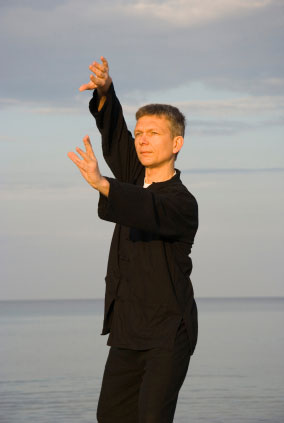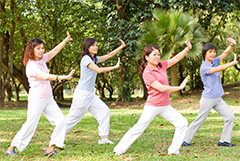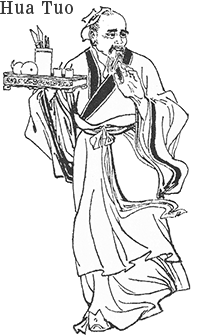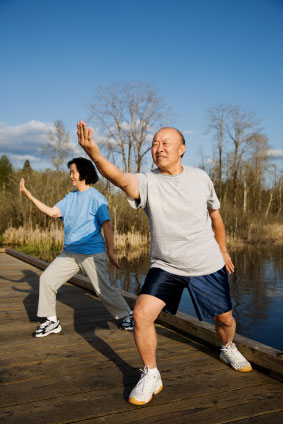QiGong
 QiGong, also known as Ch'i Kung (pronounced as “chee gung”), means “internal energy exercise / energy cultivation.” It is considered an ancient Chinese system of healing based on stimulating the flow of Qi throughout the body. Literally translated, Qi means "great air," more commonly known today as oxygen and a subtle, vital energy.
QiGong, also known as Ch'i Kung (pronounced as “chee gung”), means “internal energy exercise / energy cultivation.” It is considered an ancient Chinese system of healing based on stimulating the flow of Qi throughout the body. Literally translated, Qi means "great air," more commonly known today as oxygen and a subtle, vital energy.
QiGong is one of the four pillars of Oriental medicine:
![]() Acupuncture
Acupuncture ![]() Chinese Herbalism & Nutrition
Chinese Herbalism & Nutrition ![]() Chinese Massage & Manipulation (Tui Na)
Chinese Massage & Manipulation (Tui Na) ![]() QiGong
QiGong
A spiritual practice, QiGong encompasses many different styles, some used to address specific health conditions and others for general health and well-being.
Loosely defined, anything that you do with the intention of harmonizing Qi (increasing and stimulating the flow of oxygen and subtle energy throughout the body) through breathing, meditation, and gentle movement, can be considered a form of QiGong. Tai chi is the most well-known forms of QiGong in the west.
A principle of Oriental medicine is that all disease stems from an imbalance of Qi flowing throughout the 12 vessels of the body. There are various points along these vessels where the flow is closest to the surface of the body. These points are called acupoints and are stimulated using acupuncture, acupressure, and massage. These vessels and acupoints cannot typically be seen by the human eye, therefore in QiGong visualization is used to “see” these vessels and visualize the oxygen-rich blood flowing freely, nourishing and healing the body.
Let's take a closer look at the principles of QiGong, how it originated, and the physical, psychological, and spiritual health benefits it offers.
Principles Of QiGong
All QiGong styles are based on the following principles:
- The mind is the presence of intention
- The eyes are the focus of intention
- The movement is the action of intention
- The breath is the flow of intention
- The posture is relaxed, rooted
- The spine is straight, supple
- The breathing is deep, abdominal
- The movements are fluid, gentle (sometimes involving almost no movement)
- There is a tranquil awareness of all that surrounds the practitioner

Practiced Worldwide
QiGong is practiced by more than 80 million people worldwide (with much more predominance in China). Today, millions in China practice QiGong daily in gyms and parks, and it is considered a basic health maintenance ritual.
Larger and larger numbers of people are now practicing QiGong in the west. The most common form is tai chi, now taught at many martial arts studios, community centers, and gyms.
Benefits of QiGong
Self-practice of QiGong teaches us to become self-aware, including an awareness of and control over involuntary bodily functions such as blood pressure and respiratory rate. Though similar in this respect to biofeedback, no technical devices are needed.
QiGong techniques are so gentle they can be practiced by the young and the elderly, and by athletes and pregnant women. It is a method of self-healing that is simple, cost-effective, and only requires 30-60 mins a day to experience significant physical and psychological benefits. QiGong practice leads to better health, increased vitality, and a sense of peaceful alertness.
Practices can be tailored to the needs of each individual, and QiGong is often used as a complimentary therapy to conventional medicine when recovering from illness or injury.
Conferences in the US and China have been held to research the benefits of QiGong. It has been shown to improve posture and respiration, promote relaxation, cause positive changes in blood chemistry, and improve alertness, self-awareness, and concentration.
Further research and experimental evidence suggests that QiGong may be beneficial for:
- Respiratory conditions (such as asthma and bronchitis, by improving gaseous exchange)
- Mental health (increasing alertness, decreasing stress, anxiety, depression, and obsessive-compulsive behavior)
- Cardiovascular health (helping to normalizing high blood pressure and cholesterol levels)(1)
- Musculoskeletal health (improving posture, balance, strength, stamina, and flexibility)
- Brain (improving cerebral flow, which may lessen the incidence/probability of stroke)
- Circulation (improving circulation of blood and lymph throughout the body)
- Chronic fatigue (higher oxygen content in the blood helps relieve fatigue)
- Chronic pain (as cells become nourished and oxygenated, pain relief is felt)
- Immunity (boosting the functioning of the immune system)(2)
- Memory retention
- Eye sight (proponents feel that QiGong can help correct nearsightedness and farsightedness)
- Stability (effective at reducing and preventing loss of balance and falling injuries among the elderly)(3)
QiGong is also practiced for longevity as it destroys/helps prevent free radicals (a major cause of tissue degeneration within the body). It does this by stimulating a naturally occurring enzyme called superoxide dismutase, which protects skin damage from free radicals.
Learn about free radicals & antioxidants...
The Essence of Oneness
QiGong increases our sensitivity to and connection with the world around us, especially with nature. Practiced outside in a natural setting, it can lead to a sense of interconnectedness with the surrounding elements, a new-found understanding of the beauty and vibrance of a flower, of feeling the sense of grounding and timelessness from an oak tree. It can lead to a profound sense of understanding of the nature of reality, and that the universe is always perfectly balanced with everything happening in its own perfect time. These feelings can stimulate our creative abilities through mediums such as art and writing.
Healing therapies...
- Oriental medicine (Acupuncture, Chinese Herbalism, Tui Na, QiGong)
- Ayurveda
- Homeopathy
- Bach Flower Remedies





 Although QiGong techniques have become popular in the west (with tai chi being the most recognized and widely known), the training is not standardized and certification/licensing is not required.
Although QiGong techniques have become popular in the west (with tai chi being the most recognized and widely known), the training is not standardized and certification/licensing is not required.